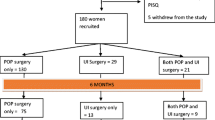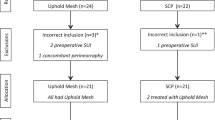Abstract
Introduction and hypothesis
This was a planned secondary analysis of a systematic review that described sexual function outcomes following pelvic organ prolapse (POP) surgery. We aimed to describe the relationship of pre- and postoperative vaginal anatomic measures with sexual function outcomes. Data Sources included the Medline, Embase, and clinicaltrials.gov databases from inception to April 2018.
Methods
The original systematic review included prospective, comparative studies that reported sexual function outcomes before and following POP surgery. Studies were extracted for population characteristics, sexual function outcomes, and vaginal anatomy, including total vaginal length (TVL) and genital hiatus. By meta-regression, we analyzed associations across studies between vaginal anatomic measurements and sexual function using the Pelvic Organ Prolapse/Urinary Incontinence Sexual Function Questionnaire-12 (PISQ-12) and dyspareunia outcomes.
Results
We screened 3124 abstracts and identified 74 papers representing 67 original studies. Among these, 14 studies reported TVL and PISQ-12 outcomes. Nine studies reported TVL and dyspareunia outcomes, eight studies reported GH and PISQ-12 outcomes, and seven studies reported GH and dyspareunia outcomes. We found no associations between anatomic measures and PISQ-12 or dyspareunia, although, we found a statistically significant association found between preoperative TVL and change in PISQ-12.
Conclusion
Across studies, the evidence does not support an association between vaginal anatomy and either validated, condition-specific sexual function questionnaires or dyspareunia. However, no study has directly analyzed these associations in the setting of pelvic floor reconstructive surgery.



Similar content being viewed by others
References
Wu JM, Matthews CA, Conover MM, Pate V, Jonsson Funk M. Lifetime risk of stress urinary incontinence or pelvic organ prolapse surgery. Obstet Gynecol. 2014;123(6):1201–6. https://doi.org/10.1097/AOG.0000000000000286.
Pauls RN, Segal JL, Silva WA, Kleeman SD, Karram MM. Sexual function in patients presenting to a urogynecology practice. Int Urogynecol J Pelvic Floor Dysfunct. 2006;17(6):576–80. https://doi.org/10.1007/s00192-006-0070-5.
Sung VW, Rogers RG, Barber MD, Clark MA. Conceptual framework for patient-important treatment outcomes for pelvic organ prolapse. Neurourol Urodyn. 2014;33(4):414–9. https://doi.org/10.1002/nau.22397.
Dietz V, Maher C. Pelvic organ prolapse and sexual function. Int Urogynecol J. 2013;24(11):1853–7. https://doi.org/10.1007/s00192-013-2176-x.
Antosh DD, Kim-Fine S, Meriwether KV, Kanter G, Dieter AA, Mamik MM, et al. Changes in sexual activity and function after pelvic organ prolapse surgery: a systematic review. Obstet Gynecol. 2020;136(5):922–31. https://doi.org/10.1097/AOG.0000000000004125.
Abramov Y, Gandhi S, Botros SM, Goldberg RP, Sherman W, Rurak M, et al. Do alterations in vaginal dimensions after reconstructive pelvic surgeries affect the risk for dyspareunia? Am J Obstet Gynecol. 2005;192(5):1573–7. https://doi.org/10.1016/j.ajog.2004.10.628.
Weber AM, Walters MD, Piedmonte MR. Sexual function and vaginal anatomy in women before and after surgery for pelvic organ prolapse and urinary incontinence. Am J Obstet Gynecol. 2000;182(6):1610–5. https://doi.org/10.1067/mob.2000.107436.
Rogers RG, Coates KW, Kammerer-Doak D, Khalsa S, Qualls C. A short form of the pelvic organ prolapse/urinary incontinence sexual questionnaire (PISQ-12). Int Urogynecol J Pelvic Floor Dysfunct. 2003;14(3):164–8; discussion 168. https://doi.org/10.1007/s00192-003-1063-2.
Wan X, Wang W, Liu J, Tong T. Estimating the sample mean and standard deviation from the sample size, median, range and/or interquartile range. BMC Med Res Methodol. 2014;14:135. https://doi.org/10.1186/1471-2288-14-135.
Hozo SP, Djulbegovic B, Hozo I. Estimating the mean and variance from the median, range, and the size of a sample. BMC Med Res Methodol. 2005;5:13. https://doi.org/10.1186/1471-2288-5-13.
Altman D, Vayrynen T, Engh ME, Axelsen S, Falconer C, Nordic Transvaginal Mesh G. Anterior colporrhaphy versus transvaginal mesh for pelvic-organ prolapse. N Engl J Med. 2011;364(19):1826–36. https://doi.org/10.1056/NEJMoa1009521.
de Tayrac R, Cornille A, Eglin G, Guilbaud O, Mansoor A, Alonso S, et al. Comparison between trans-obturator trans-vaginal mesh and traditional anterior colporrhaphy in the treatment of anterior vaginal wall prolapse: results of a French RCT. Int Urogynecol J. 2013;24(10):1651–61. https://doi.org/10.1007/s00192-013-2075-1.
Gutman RE, Nosti PA, Sokol AI, Sokol ER, Peterson JL, Wang H, et al. Three-year outcomes of vaginal mesh for prolapse: a randomized controlled trial. Obstet Gynecol. 2013;122(4):770–7. https://doi.org/10.1097/AOG.0b013e3182a49dac.
Kokanali MK, Cavkaytar S, Aksakal O, Doganay M. McCall Culdoplasty vs. sacrospinous ligament fixation after vaginal hysterectomy: comparison of postoperative vaginal length and sexual function in postmenopausal women. Eur J Obstet Gynecol Reprod Biol. 2015;194:218–22. https://doi.org/10.1016/j.ejogrb.2015.09.023.
Kraus P, Krofta L, Krcmar M, Urbankova I, Gojis O, Grogregin K, et al. The results of five years follow-up prospective study of vaginal prolapse repaired by prolift total mesh surgery or sacrospinous fixation. Ceska Gynekol. 82(4):277–86.
Li S, Ji M, Zhao Z. The effectiveness of two different laparoscopic surgeries for apical support of pelvic organ prolapse. Eur J Obstet Gynecol Reprod Biol. 2015;188:74–8. https://doi.org/10.1016/j.ejogrb.2015.03.007.
Nguyen JN, Burchette RJ. Outcome after anterior vaginal prolapse repair: a randomized controlled trial. Obstet Gynecol. 2008;111(4):891–8. https://doi.org/10.1097/AOG.0b013e31816a2489.
Paraiso MF, Barber MD, Muir TW, Walters MD. Rectocele repair: a randomized trial of three surgical techniques including graft augmentation. Am J Obstet Gynecol. 2006;195(6):1762–71. https://doi.org/10.1016/j.ajog.2006.07.026.
Paraiso MF, Jelovsek JE, Frick A, Chen CC, Barber MD. Laparoscopic compared with robotic sacrocolpopexy for vaginal prolapse: a randomized controlled trial. Obstet Gynecol. 2011;118(5):1005–13. https://doi.org/10.1097/AOG.0b013e318231537c.
Rudnicki M, Laurikainen E, Pogosean R, Kinne I, Jakobsson U, Teleman P. Anterior colporrhaphy compared with collagen-coated transvaginal mesh for anterior vaginal wall prolapse: a randomised controlled trial. BJOG. 2014;121(1):102–10; discussion 110-101. https://doi.org/10.1111/1471-0528.12454.
Salamon CG, Lewis CM, Priestley J, Culligan PJ. Sexual function before and 1 year after laparoscopic sacrocolpopexy. Female Pelvic Med Reconstr Surg. 2014;20(1):44–7. https://doi.org/10.1097/SPV.0000000000000046.
Svabik K, Martan A, Masata J, El-Haddad R, Hubka P. Comparison of vaginal mesh repair with sacrospinous vaginal colpopexy in the management of vaginal vault prolapse after hysterectomy in patients with levator ani avulsion: a randomized controlled trial. Ultrasound Obstet Gynecol. 2014;43(4):365–71. https://doi.org/10.1002/uog.13305.
Ucar MG, Ilhan TT, Sanlikan F, Celik C. Sexual functioning before and after vaginal hysterectomy to treat pelvic organ prolapse and the effects of vaginal cuff closure techniques: a prospective randomised study. Eur J Obstet Gynecol Reprod Biol. 2016;206:1–5. https://doi.org/10.1016/j.ejogrb.2016.08.041.
Withagen MI, Milani AL, den Boon J, Vervest HA, Vierhout ME. Trocar-guided mesh compared with conventional vaginal repair in recurrent prolapse: a randomized controlled trial. Obstet Gynecol. 2011;117(2 Pt 1):242–50. https://doi.org/10.1097/AOG.0b013e318203e6a5.
Milani AL, Withagen MI, The HS, Nedelcu-van der Wijk I, Vierhout ME. Sexual function following trocar-guided mesh or vaginal native tissue repair in recurrent prolapse: a randomized controlled trial. J Sex Med. 2011;8(10):2944–53. https://doi.org/10.1111/j.1743-6109.2011.02392.x.
Schimpf MO, Harvie HS, Omotosho TB, Epstein LB, Jean-Michel M, Olivera CK, et al. Does vaginal size impact sexual activity and function? Int Urogynecol J. 2010;21(4):447–52. https://doi.org/10.1007/s00192-009-1051-2.
Weber AM, Walters MD, Schover LR, Mitchinson A. Vaginal anatomy and sexual function. Obstet Gynecol. 1995;86(6):946–9. https://doi.org/10.1016/0029-7844(95)00291-x.
Ercan O, Ozer A, Kostu B, Bakacak M, Kiran G, Avci F. Comparison of postoperative vaginal length and sexual function after abdominal, vaginal, and laparoscopic hysterectomy. Int J Gynaecol Obstet. 2016;132(1):39–41. https://doi.org/10.1016/j.ijgo.2015.07.006.
Tan JS, Lukacz ES, Menefee SA, Luber KM, Albo ME, Nager CW. Determinants of vaginal length. Am J Obstet Gynecol. 2006;195(6):1846–50. https://doi.org/10.1016/j.ajog.2006.06.063.
Abdelmonem AM. Vaginal length and incidence of dyspareunia after total abdominal versus vaginal hysterectomy. Eur J Obstet Gynecol Reprod Biol. 2010;151(2):190–2. https://doi.org/10.1016/j.ejogrb.2010.03.031.
Bland JM, Altman DG. Multiple significance tests: the Bonferroni method. BMJ. 1995;310(6973):170. https://doi.org/10.1136/bmj.310.6973.170.
Balk; DAKVMSK-FE, Rogers ADGKMMRSMGAAMFDDRRG Quality of Sexual Function Outcome Reporting in Pelvic Organ Prolapse Trials. In: Society of Gynecologic Surgeons 46th Annual Scientific Meeting, 2020.
Rogers RG, Rockwood TH, Constantine ML, Thakar R, Kammerer-Doak DN, Pauls RN, et al. A new measure of sexual function in women with pelvic floor disorders (PFD): the pelvic organ prolapse/incontinence sexual questionnaire, IUGA-revised (PISQ-IR). Int Urogynecol J. 2013;24(7):1091–103. https://doi.org/10.1007/s00192-012-2020-8.
Rogers RG, Pauls RN, Thakar R, Morin M, Kuhn A, Petri E, et al. An international Urogynecological association (IUGA)/international continence society (ICS) joint report on the terminology for the assessment of sexual health of women with pelvic floor dysfunction. Int Urogynecol J. 2018;29(5):647–66. https://doi.org/10.1007/s00192-018-3603-9.
Acknowledgements
The authors acknowledge the generous support of the members and Executive Committee of the Society of Gynecologic Surgeons.
This work is supported by the Society of Gynecologic Surgeons (SGS), members of which comprise the Systematic Review Group that performed this review.
Funding
SGS provides no direct funding for this study but supports the organization with provision of meeting space and oversight, stipends for methodology expert and statistical support, and aids in the dissemination of study findings. All work being presented here for publication has been disclosed to and reviewed by the Executive Committee of SGS prior to this submission.
Author information
Authors and Affiliations
Corresponding author
Ethics declarations
Conflicts of interest
None.
Additional information
Publisher’s note
Springer Nature remains neutral with regard to jurisdictional claims in published maps and institutional affiliations.
Study Registration
This systematic review is registered with PROSPERO (CRD42019124308).
Rights and permissions
About this article
Cite this article
Kim-Fine, S., Antosh, D.D., Balk, E.M. et al. Relationship of postoperative vaginal anatomy and sexual function: a systematic review with meta-analysis. Int Urogynecol J 32, 2125–2134 (2021). https://doi.org/10.1007/s00192-021-04829-4
Received:
Accepted:
Published:
Issue Date:
DOI: https://doi.org/10.1007/s00192-021-04829-4




